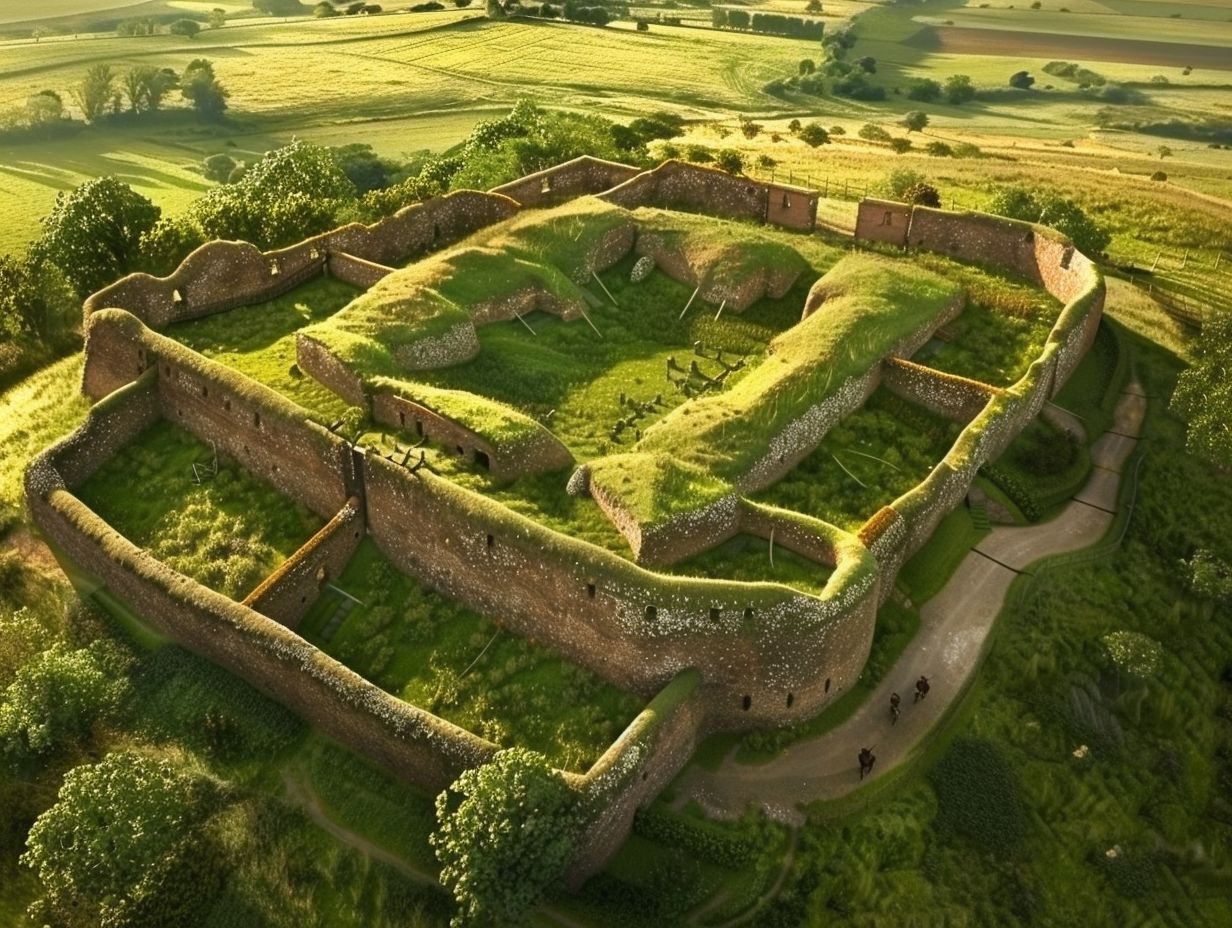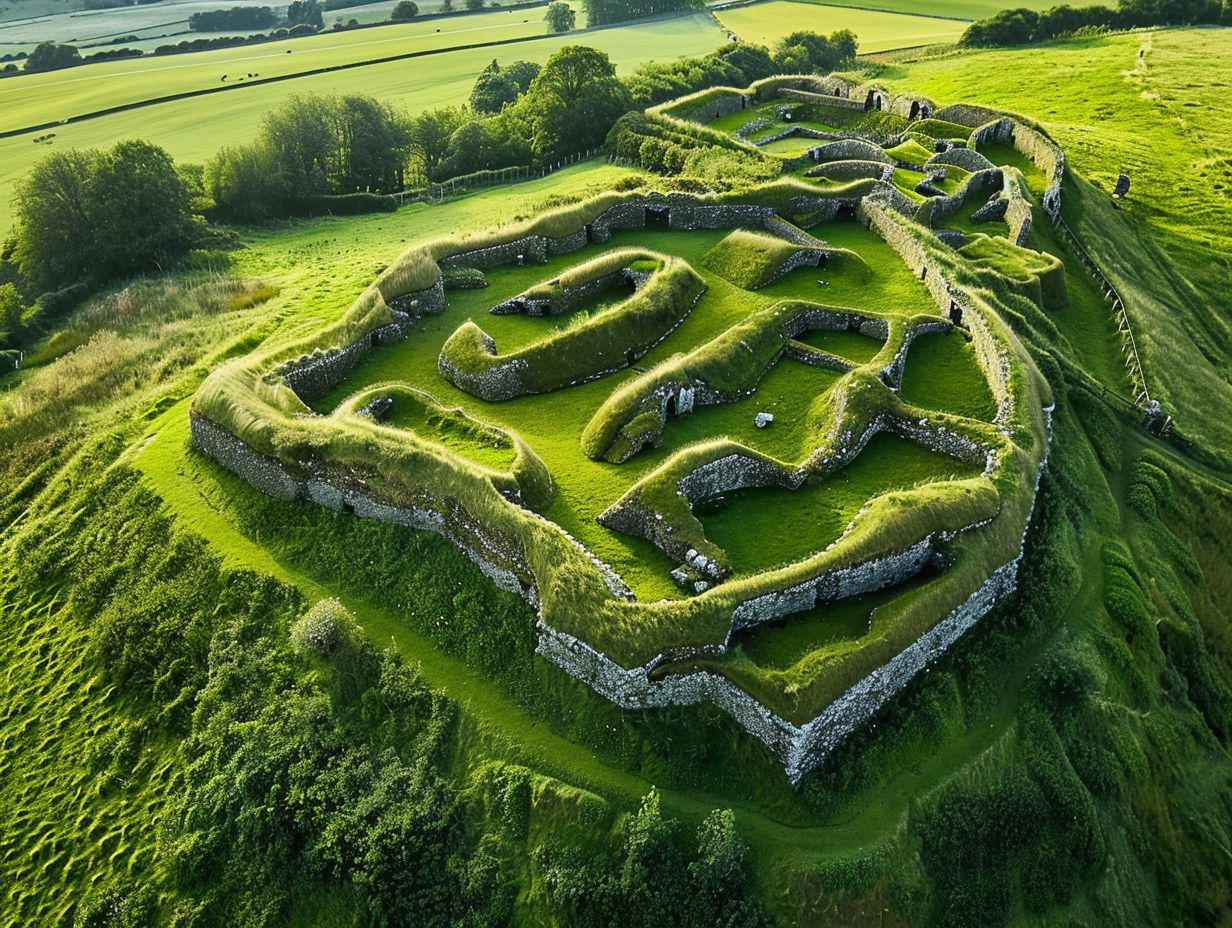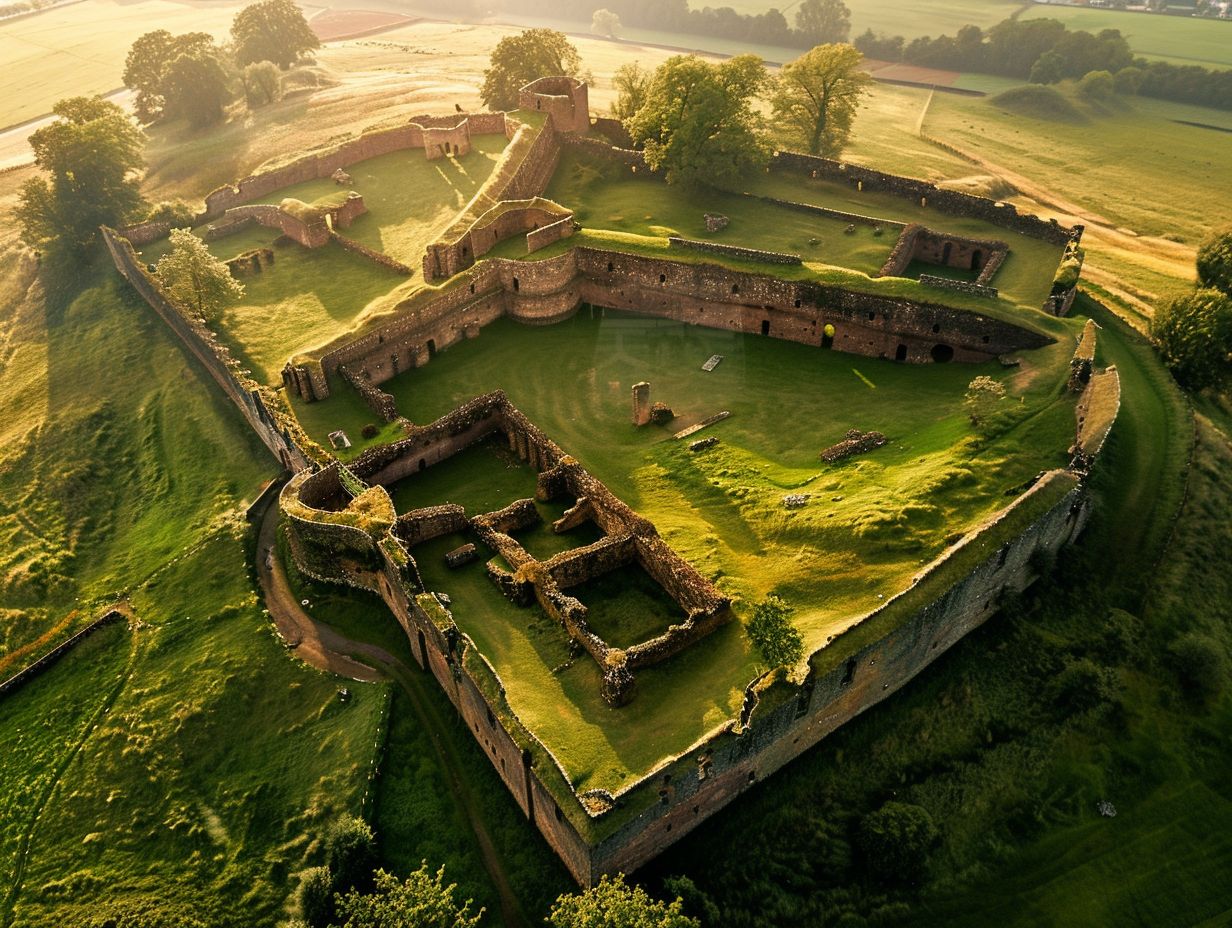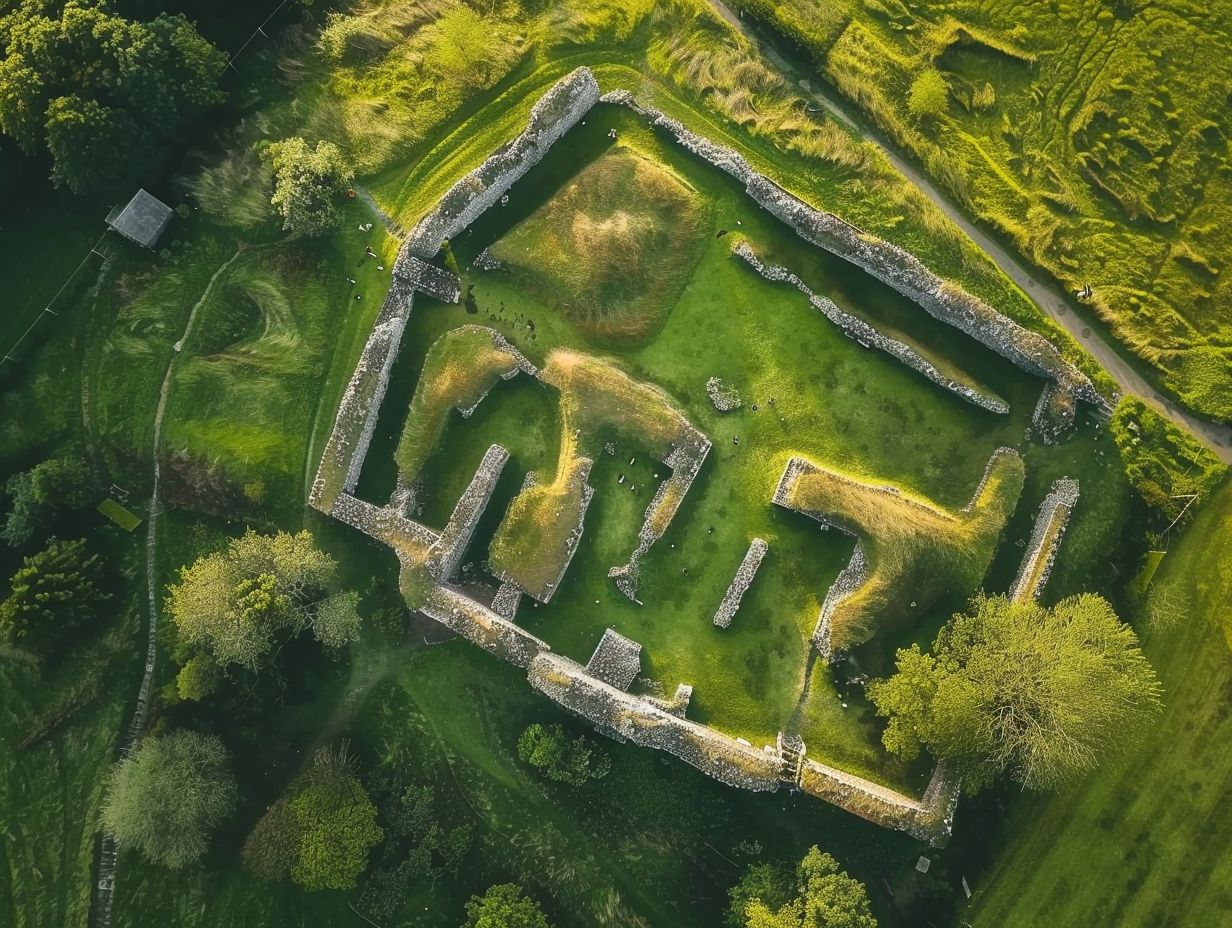Embark on a journey through the extensive history and importance of Britain’s Roman forts and camps. Delve into the various types of structures and their distinct designs, uncovering their locations spanning the country. Explore the captivating realm of Roman military architecture.
Discover how these age-old ruins have made a lasting impression on British society and culture. Learn about how you can visit and explore these historic sites firsthand.
Key Takeaways:

- Explore the rich history and purpose behind Britain’s Roman forts and camps, which served as strategic military bases and administrative centers during the Roman occupation.
- Discover the various types of forts and camps, each with unique designs and features, and gain insight into the Roman military’s advanced engineering techniques.
- Uncover the locations of these structures through mapping and visit and explore the well-preserved ruins to gain a deeper understanding of their significance in British history and impact on society and culture.
Types of Roman Forts and Camps
Different types of Roman forts and camps were strategically built in Arabia, each fulfilling specific purposes determined by their design and layout. Ranging from circular marching camps to square-shaped forts accommodating a cavalry unit, the Roman military employed a variety of architectural styles to assert control and dominance in the region.
Different Designs and Features
The Roman forts and camps in Arabia demonstrate a range of designs and characteristics specifically tailored to both the topography and strategic demands of the period.
These architectural marvels and military installations highlight the Roman military’s versatility in adapting to different terrains and operational necessities.
A notable aspect of these Roman forts and camps in Arabia is their strategic location within the landscape, often situated on elevated ground to enhance visibility and defence capabilities.
The incorporation of defensive structures like walls, towers, and gates not only provided security but also defined a clear perimeter for the fortifications.
The layout of these forts was meticulously designed to encompass various functional zones such as barracks, command centres, and storage facilities, all strategically placed to optimise operational effectiveness.
Locations of Roman Forts and Camps in Britain

The locations of Roman forts and camps in Britain, especially in Scotland, provide valuable insights into the presence of Roman military forces in the region. Researchers such as Rebecca Jones from Historic Environment Scotland have conducted thorough studies of these sites to understand their historical context and strategic significance.
Mapping out the Sites
Mapping out the Roman forts and camps in Britain involves a meticulous process of archaeological exploration and site documentation to reveal the historical footprint of Roman military activities.
These mapping endeavours aim to create a comprehensive understanding of the spatial distribution and strategic layout of these ancient structures.
By employing various cartographic techniques such as aerial surveys, ground-penetrating radar, and geophysical imaging, you can accurately map out the dimensions and alignments of these forts and camps.
Through this detailed documentation, historians can decipher the strategic significance of these military outposts and analyse how they interacted with the surrounding landscape.
Uncovering these insights not only sheds light on Roman military tactics and infrastructure but also provides a glimpse into the daily lives of soldiers stationed at these key locations.
Discovering Roman Forts and Camps Today
The exploration of Roman forts and camps remains a source of fascination for archaeologists and researchers. Recent discoveries in locations such as Dûmat al-Jandal are providing new insights into Roman military operations in the area.
Revealing these ancient structures provides valuable information on the strategic placement and historical importance of the Roman presence.
Visiting and Exploring the Ruins
Visiting and exploring the ruins of Roman forts and camps provides you with a captivating journey into the past, allowing both enthusiasts and historians to witness firsthand the remnants of ancient military structures.
These archaeological sites offer a tangible connection to history, inviting you to immerse yourself in the legacy of Roman military presence.
Exploring these ruins will offer you valuable insights into the strategic planning and architecture of the Roman Empire, showcasing the advancements in engineering and defence techniques of that era.
As you walk through the ancient stone walls and decaying barracks, you can envision the daily lives of Roman soldiers and understand the challenges they faced.
Preserving these sites not only conserves physical artefacts but also safeguards invaluable historical narratives for future generations, fostering a deeper appreciation for our shared human heritage.
Significance of Roman Forts and Camps in British History

The Roman forts and camps in British history bear significant importance, moulding the societal and cultural landscape of the region during antiquity.
These military structures not only signified the presence of Roman forces but also impacted the growth of local communities and cultural interactions within the wider historical framework.
Impact on Society and Culture
The Roman forts and camps left a lasting impact on the societal and cultural dynamics of the Nabataean Kingdom and the broader region, especially after the events of AD 106 CE.
The military presence reshaped political landscapes, trade routes, and cultural interactions, leaving a profound legacy on the historical narrative of Arabia.
This transformation was significant not only in terms of military conquest but also in the enduring cultural and societal changes it brought about.
The Roman military infrastructure not only enhanced defence but also functioned as pivotal points for economic activities, promoting trade and commerce that linked distant regions.
Consequently, the region experienced a convergence of diverse cultures, languages, and traditions, creating a melting pot of influences that fundamentally altered the social fabric for generations to come.
The legacies of these Roman constructions continue to influence archaeological discoveries and historical interpretations in the contemporary era.
Frequently Asked Questions
What is the significance of discovering Britain’s Roman Forts and Camps?
The discovery of Britain’s Roman forts and camps provides insight into the history and impact of Roman occupation in Britain. These structures serve as physical evidence of the Roman military presence and their influence on the development of Britain.
How many Roman forts and camps have been discovered in Britain?

As of 2021, over 2,000 Roman forts and camps have been discovered in Britain. This number continues to grow as new archaeological discoveries are made.
What is the difference between a Roman fort and a Roman camp?
A Roman fort was a permanent military base built by the Romans to house soldiers and serve as a strategic stronghold. A Roman camp, on the other hand, was a temporary military camp used for brief periods during military campaigns.
What were some common features of Roman forts and camps?
Roman forts and camps were typically rectangular in shape and surrounded by defensive walls or ditches. They also had gateways for entry and exit, and were often situated near important roads or water sources for ease of access.
How were Roman forts and camps built?
Roman forts and camps were built using a combination of manpower, tools, and local materials. Soldiers would typically use their standard issue tools such as spades, shovels, and pickaxes to construct these structures, while local materials like stone, timber, and turf were used for the walls and buildings.
Can the public visit and explore these Roman forts and camps?
Many of the discovered Roman forts and camps are open to the public for exploration and educational purposes. Some even have on-site museums and guided tours available. However, it is important to always follow the designated paths and respect the historical significance of these sites.



